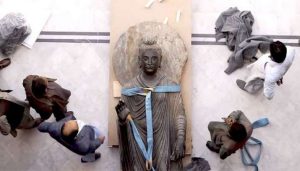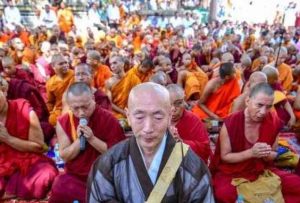Dr. Sneha Rooh is a palliative care physician and researcher from Hyderabad, India. She has been developing a palliative care program that teaches Buddhist monastics how to care for the dying and terminally ill. In this article for our special issue, she looks back on a recent period of major disruption in her life, starting from the devastating second wave of COVID-19 infections in India over the month of April.
“We don’t need your services anymore.”
They say that lines jump out at you, and I could not stop frantically reading this one from a short, brusque email from my previous employer, a leading organization on the forefront of palliative care in India. I was working as a research assistant in the team that had been developing a curriculum for the past six months, and I had developed an entire module for Buddhist monastics and added an exciting new chapter in our manual. I had a grand picture in my head of how the new edition would look.
This was supposed to be the team that would help me realize my dream to set up palliative care centres worldwide. This team should have been the one that would have published the children’s book on grief that I wrote in multiple languages on their website. I had so many dreams to accomplish. In my mind, this was the organisation that would lead me to those places.
The COVID-19 crisis
The pandemic hit India the hardest just when we thought it was almost over: “2020 is over; we have weathered the pandemic,” everyone thought. People had started going to their offices and were visiting friends again. Then, all of a sudden, social media were flooded with requests for oxygen cylinders. People who usually post memes were holding empty vials of Amphotercin B, desperate to know where it could be found. My world had effectively collapsed. For many Indians, the world at large was crumbling beyond anyone’s expectations.
The greatest devastation was happening in my inner world. I had no personal sources of support to tap into. My middle-class, business-oriented family did not consider what I was doing to be a “real doctor’s job.” I did not have a stethoscope or a white lab coat, I did not work in a “reputable” hospital, and now I did not even have institutional backing. I was creating modules that no one wanted, whether they were for monasteries or hospitals. Attacks flew at me in the form of questions, ostensibly about my well-being, among them: “Why not start working night shifts at hospitals on locum as a duty doctor instead of struggling in a field that is not yet formed, doesn’t pay, and more importantly, doesn’t want you?”
My father, who runs a home for seniors, treated me like I was invisible. My elder brother had no time for my struggle, and my younger brother was telling me how no one would read my books because I was a nobody. My mother was shaming me for not marrying: I was 32 and, given my circumstances, not ideal material in her eyes. My family even told me not to be vaccinated under the doctors’ quota. They spoke as if the last six years hadn’t happened; as if I wasn’t actively involved in training people in palliative care, as if I had not spent so much time and energy advocating it; as if the very helpful death cafés I had run had never happened and I had never designed the modules or written my book chapters.
What was even more frightening was that I believed them. The identity to which I had clung to for so long was slipping away because I was being gaslit into thinking I had never had it or deserved it to begin with.
Buddhism for when things fall apart
I was barely holding on after my professional crisis, but I was still able to tap into my inner resources. I had a strategy for each day, settling on an activity that would carry me through. On some days I would write letters of forgiveness to my parents, on others I would write an acceptance speech for myself. Sometimes I would paint images with vivid watercolours, and one day I found an online list of actions to heal your inner child. I decided that the during this time I would check as many items as possible from my list. That list suggested some healing acts that I tried with some success. These were just a few: I learned how to say “you are beautiful” in seven languages. I made a list of every compliment I remember receiving. And at a written prompt, I went to the community library to find books to read.
Among the books in that library was one orange book, the only book on Buddhism. It was an anthology called The Path of the Buddha (2003) and I soaked it in. It felt like receiving teachings from a master whose face and voice changed with every turned page.
When you are in such a low place, you have little choice but to accept and be grateful that what happened has come to pass. I took just one weekend to read the book I had acquired, taking breaks to reflect on its message. I needed a balm and the book provided that. And I found my breath somewhere along the way while reading it. The next day I wrote again to all the people I had contacted over the past few months about my palliative care module for monastics, “Dharma Beyond Beads.” Slowly, I was regaining faith in my efforts.
When I look back over my notebook and reflect on how the teachings I jotted down changed the course of my life in my darkest period, several points come to mind:
1. “Human life has suffering present in it, no matter what we do.” My work in palliative care and my aspiration to make it available for monastics does not necessarily protect me from suffering.
2. “Reality is composed of interdependent parts. Things happen for various reasons.” My previous organization never accepted the module I had prepared, even though they were working with people in Bhutan. Perhaps it was not so much to do with my caliber (or lack thereof) or the module. Maybe there was more at play than what was visible.
3. “What seems to you a prison may be a sanctuary to another.” Maybe my crisis could, with more practice, be quite welcome as a chance to experience impermanence deeply?
4. “Doubt is positive if investigated, but negative when allowed to fester.” Was there truth behind the doubts that I had in myself, or the doubt that others felt toward me? What exactly did I really have to offer? And who was asking for it? Reflecting on such questions made me look at the hard facts of what I was doing, renew my certification as an arts-based therapist, acknowledge my love for writing, and build my own website where people can consult with me on treatment (and also to set up palliative care units in their locality).
5. “If I understand what I want, I will realise where I don’t belong.” I understood that through desiring all sorts of accomplishments with regard to palliative care, I was really longing for public recognition. I was hoping for the transformation of myself through the practice of palliative medicine. I was longing for my work to become my spiritual practice. As such, I have had an opportunity to reflect on what I really want and how I can attain it.
I know that this will not be the last time I face a desperate situation. I am not even sure if I can say that I have pulled through this one successfully. I understand that sitting with, watching, and transforming emotions, no matter how dark, is not easy. But that is the only thing we can do. Living in nature greatly helped me through this process, as did chancing upon that book and becoming non-attached. But most importantly, I think the fact that I acted on my own behalf, sought help, and re-examined my deeper aspirations helped me immensely. If I have learnt anything from practitioners of all levels, it is the individual that must choose their own path of healing.
See more
Sneha Rooh (Death Cafe)
Related features from Buddhistdoor Global
Trauma Dharma
Dharma Amid Coronavirus
Finding Radiance in Difficult Times
Related columns from Buddhistdoor Global
Death Dhamma by Margaret Meloni
Related podcasts from Buddhistdoor GlobalThe Death Dhamma Podcast by Margaret Meloni (YouTube)
Buddhistdoor Global Special Issue 2021: Humanity in Transition












